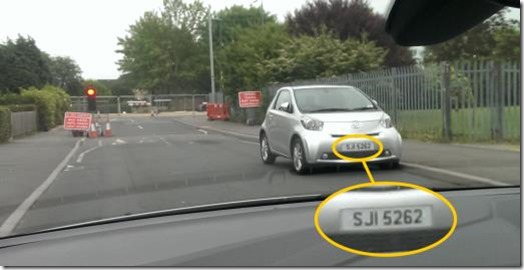As of June 2019, this article has received a few hits. Please note that it is an old post and is not relevant any longer. DVSA allows recording of tests using dashcams now (but still not the audio). Indeed, I often use dashcam footage to show pupils where they went wrong. However, the original post is still of interest because of what was being advised at the time I wrote it. Namely, covert recording of tests at a time when DVSA (or DSA as it was) did not allow it.
Back in February I commented on a story that had come through on the newsfeeds concerning advice from PoliceWitness.com. The company sells in-car cameras, and in a story published in Fleet News, it was stated:
Learner drivers are being encouraged to film their driving tests, covertly if necessary, by PoliceWitness.com.
Earlier today, I received an email from PoliceWitness.com. The full text is as follows (with their permission):
Dear Sir,
I am writing with reference to your post on your website, diary of an adi: https://www.diaryofanadi.co.uk/?p=14855 which states that PoliceWitness.com has given irresponsible advice about filming driving tests.
I wanted to take the opportunity to clear up any confusion and thought it would be useful to update you on our recent correspondence with Alastair Peoples, the Chief Executive of the DVSA.
On your website you state “PoliceWitness is getting itself into a very muddy area, since unless an examiner gives permission such recording could be a breach of the Data Protection Act”.
When we contacted Alastair Peoples and asked about the DPA and filming of driving tests, his reply was “…You suggested that we have used the Data Protection Act as the reason why we do not allow the filming of driving tests. This is not the case. While it is true there are data protection issues associated with the recording of tests, the main reason we do not allow tests to be recorded is that a single video camera mounted in a test car could not provide an accurate record of everything that happened on test”.
We have had several subsequent letters from Mr Peoples who has recently advised, and I quote “As you may appreciate, there are many issues to take into account when considering the recording of driving tests. For many years, our position has been – aside from a few very exceptional circumstances – that we did not allow the recording of live tests. This policy developed largely from our concerns that the recording of tests from inside a vehicle could have been a breach of the Data Protection Act. We were also concerned that footage from a single, internally-mounted camera could not show a true representation of events both inside and outside the vehicle. There is also the possibility that a recording could be altered to show something different from what actually happened.
We are, however, aware that times change and cars that are fitted with cameras, telematics systems and other forms of recording devices for insurance purposes are becoming more common. It is difficult to foresee how we could exclude vehicles with these technologies from
testing, neither would we wish to do so. We are committed to working with stakeholders to design a modern and relevant driver training and testing regime that delivers safe and responsible drivers and riders. It is clear that the current position on the recording of driving tests needs to be reviewed and we are currently looking into that. During that review the safety of test candidates, examiners and other road users, and the integrity of the driving test must take priority. Once we have completed our review we will publicise the outcome through the usual communication channels”
As a driving instructor (are you based in Nottingham?) I thought you might be interested to hear about the driving test review that is underway and to hear how PoliceWitness.com is supporting many DI’s who have dash cams installed, not only to protect themselves on the road but to use them as a training tool for their pupils.
I hope you have found the update from Mr Peoples useful and would be interested to hear your thoughts on the matter.
Kind regards,
Paul
Customer Services
With a proven track record of holding bad drivers to account, we have been instrumental in changing driving standards for the better.
Our most significant step forward of late has been to secure genuine insurance reductions for those using a dash cam.
Unlike many insurers that merely use ‘x% off’ as a marketing message, we’ve gone straight to an underwriter who already recognised and understood the benefits of a dash cam during a claim.
As such we guarantee to reduce our members insurance costs. Even beating the likes of Direct Line and Aviva. An announcement will follow.
In my response, I included an email I received from DSA (now, DVSA) in February this year, which I also include in full, below (I have underlined the significant portions):
Dear [DOAADI]
Thank you for your email of 3 February about using video equipment to record a practical driving test. I appreciate you bringing this matter to our attention. I have informed our relevant departments who will also investigate further if necessary.
We do not allow people to record driving tests as images and/or audio recorded consist of, in most cases, the personal data of the examiner. This means that the images or recordings are subject to the Data Protection Act (DPA).
The fact the act is employed means that the Approved Driving Instructor must ensure the processing of this personal data is ‘Fair’ and they satisfy certain conditions that allow processing in this way. They must take account of the privacy and wishes of the person whose being filmed, especially when an individual objects to filming. Based on this, we made the decision to prohibit the filming of tests, owing to the data protection issues involved.
It is within the examiner’s rights to stop a test if they become aware of someone filming the test without the agency’s permission. If it becomes apparent that filming equipment is active either in a test vehicle or externally, the examiner should politely ask for the equipment to be switched off. If this request is not complied with the test should be terminated.
If a test is terminated because of filming the candidate would lose their fee. If a test is filmed covertly and the examiner did not know, then all DPA laws would apply. Our position is still that we do not allow tests to be recorded because of the DPA protection implications. If a test is filmed we would not view the footage unless it is deemed to have involved criminal activity, in this instance we would send the film directly to the Police.
You can find further information here.
This is not to say that vehicles fitted with CCTV etc will be refused for test. However, the equipment must be turned off while the test occurs.
Yours sincerely
Customer Support Correspondence
Customer Operations
[old DSA email address no longer correct]
As you can see, there is a discrepancy here. Alastair Peoples says one thing, whereas the DSA part of the new DVSA says another. However, the fact remains that – at present – DVSA does not allow any form of recording to take place during tests, and I maintain that it is – at present – irresponsible to advise covert recording of driving tests.
There are a number of issues that Alastair Peoples does not seem to have considered in his comments to PoliceWitness.com. Concerning DPA, there is the fact that the majority of test candidates are under the age of 18 (and a large proportion of those are female). The Protection of Children Act (1978) was amended in 2003 to apply to anyone under the age of 18, and so the routine recording of 17-year olds will definitely raise questions – or, at the very least, put the person making such recordings in a very risky position – should the person being filmed raise any objections. I’m not saying it would definitely be in breach of the DPA and associated laws, but it is clearly sailing bloody close to the wind. Also, the inside of a tuition vehicle is not a “public place”, so as I said in that earlier article, it’s a very muddy area – and one that is best kept out of by instructors,
Furthermore – and irrespective of any possibility that recordings can be amended to show something different to what actually took place – in order for a bona fide recording to show all of the necessary information for an appeal over a test result, it would have to have been made from several simultaneous camera angles. To cover all possible situations, you would need forward- and rear-facing footage, footage from at least one camera either side of the car, and close-ups of both the examiner and the candidate. All of these channels (at least six) would have to be synchronised. Only then could you begin to address the usual “but I did check… oh no, you didn’t” claims when someone fails. And it would still need lengthy expert assessment to decipher what was going on. Mr Peoples doesn’t seem to have considered that – or how much it would cost DVSA to wade through the inevitable deluge of unfair claims that would ensue.
And yes, there is the risk of footage being edited to bolster any claim, though this is the least of any problems that might arise from allowing tests to be recorded.
You also have to remember that both VOSA and DSA have a long history of “looking into things” – and an equally long history of actually doing bugger all about any of them in the end. For Alastair Peoples to say something like this now – less than a year away from a General Election – is typical. It is likely we will have a new government this time next year, and in the meantime the existing one will be more concerned about not losing votes than it is about changing things which won’t win any. In any case, the uncertainties over the legal situation mean that changes to the Law are likely, and that means consultations. All of this is even less likely to happen inside any reasonable time frame.
I have no problem with PoliceWitness.com selling cameras for the purposes of combatting theft and fraud, but driving tests are not conducted fraudulently, give or take a few high-profile cases every few years. Advising covert recording of something which is already expressly forbidden is a bit of a contradiction in terms.
This article is getting a a fair few hits from Theory Test Pro, and an article of theirs which give 5 reasons why ADIs should use a dash cam. All of the reasons are sound – and not one of them involves recording driving tests.
As I have written before, I use a camera for training purposes – I’ve experimented with several – but recording tests is something I would never do, even if it was allowed. [EDIT 2019: I am a steaming hypocrite! I forgot I actually wrote those words until just now. Since DVSA started allowing it, I initially didn’t record tests. But then I got a camera which starts up as soon as the car is started, and I didn’t want to keep removing it, so I left it in. It’s turned out to be a Godsend in helping pupils understand what they did right/wrong on test]. There is simply no need. And there is no need for any of the many hundreds of other people who take tests daily to record theirs, either. There’s even less need for them to be egged on by someone who sells cameras on the premise that they’re being cheated out of test passes.
It must be stressed that DVSA does not object to dash cams being fitted. However, driving tests cannot be recorded [that is no longer correct in 2019, or for the last couple of years]. People seem a little confused by this, and seem to assume having the dash cam at all is a problem. It isn’t.
This article has been getting a few hits during the summer from a forum dedicated to one particular dash cam. The thread that is triggering the interest has two posts of note.
One ADI comments that he has forgotten to switch his camera off a few times on test, and that the footage makes “interesting viewing”. This is a fairly ambiguous comment – it may mean just what it says (though you can sit in on test and see exactly the same “interesting” things), or it could mean that the ADI in question disagrees with what he has seen.
However, all ambiguity is removed by another poster, who comments:
I bet they do make interesting videos! I may have to “forget” to switch mine off during test!
Regular readers will know that I often refer to the attitudes of some ADIs, and how this us-and-them approach to the DVSA doesn’t do anyone any favours. Deliberately suggesting that DVSA rules are going to be broken – and the current rule IS that no videoing of tests is allowed – is… well, you can work it out for yourself.
I’m sure some people become ADIs just to cause trouble. There is no need whatsoever for 99.9% of tests to be recorded, and the remaining 0.1% is insufficient (and insignificant enough) to justify that they should be! The DVSA is NOT routinely doing anything that warrants covert filming, and it is nauseating to keep hearing camera vendors, disgruntled pupils, and even ADIs suggest that they are.
Note this update from September 2014. DVSA will now allow insurance cameras to be fitted and running, but you still cannot record driving tests per se or any audio, nor will DVSA enter into any form of discussion about disputes arising from such insurance video footage.
My original assertion that advising people to covertly record their tests is irresponsible still stands. However, I do think DVSA has shot itself in the foot (albeit with a spud gun) over this.
I don’t think they should have changed their original stance.
Note the edits in this post. I forgot I’d written it until it started getting hits in June 2019. I have done a U-turn and record tests (but never audio). It is very useful. But note that the original purpose of the post was valid – at the time, DVSA (or DSA as it was called then) didn’t allow recording at all, and the company referred to was advising covert recording in complete opposition to that – apparently with the suggestion that test fails could be appealed.
DVSA will not entertain an appeal based on video footage for the reasons already given.



